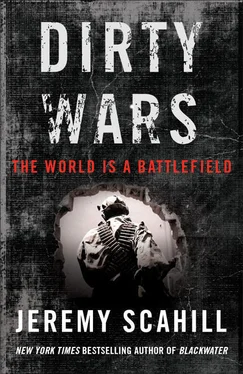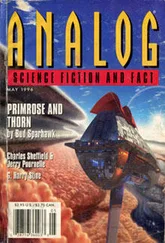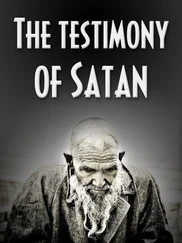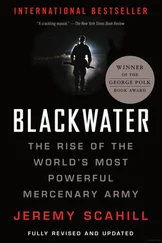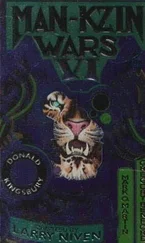After 9/11, no more than two dozen men were on the US kill list. Once McRaven got to work, the list grew every year. After helping build the structure for JSOC to engage in a global manhunt, McRaven would finally forward deploy to implement it. There are “three people who really improved Special Operations Forces and who can claim a great amount of credit for the way they have developed since 2001,” Exum told me. “You can look at Bill McRaven, you look at Stan McChrystal and you look at Mike Flynn.”

10. “Their Intention and Our Intention Is the Same”
SOMALIA, 1993–2004—In early January 2003, Mohamed Afrah Qanyare stood on the tarmac of the secluded airstrip he controlled just a few clicks north of Mogadishu. The tiny airport was a small fortress in a dangerous, lawless nation. Qanyare’s private security force guarded its perimeter and land mines were strategically scattered “in the bush,” making a sneak attack—or, for that matter, a casual visit—very risky. In the years following the fall of dictator Mohamed Siad Barre—who headed Somalia’s last stable government—Qanyare had emerged as one of the most powerful warlords who ravaged Mogadishu and laid claim to their own plots of territory. The Daynile airstrip was Qayare’s fiefdom. And it brought in money. A lot of money. For a decade, the airport’s profits overwhelmingly came from smuggling mira, or khat, the addictive, narcotic-like leaf that is chewed by millions throughout the Horn of Africa and the Arabian Peninsula. It was the drug of choice among the thousands of militiamen who fought for Qanyare and his fellow warlords and a major factor in the insanity that had long gripped Somalia. But on this particular day—January 5, 2003—the aircraft that Qanyare awaited on the tarmac was not a Bluebird Aviation flight bringing in the foliage of chaos, but rather a small Gulfstream that carried a different kind of volatile cargo.
Qanyare said he couldn’t recall which government agency the white men who stepped off the plane that day worked for, but they were definitely Americans. “I believe they were special military intelligence and CIA,” Qanyare remembered. “But I really don’t know. That’s internal business for them. They were intelligence, American intelligence.”
A few weeks earlier, Qanyare had been approached by a trusted friend who told him the CIA wanted to meet with him in Nairobi, Kenya. The day after Christmas, Qanyare sat in a hotel room with a handful of white men. “They requested to get together and I accepted, because America is a world power,” he remembered. “We discussed intelligence business.” The business they discussed was Washington’s desire to track down and eliminate a small group of al Qaeda operatives on the CIA and JSOC radar. Among them, the Americans told Qanyare, were dangerous men who had planned and carried out the 1998 bombings of the US embassies in Kenya and Tanzania, killing more than two hundred people. Washington, they told Qanyare, was concerned that al Qaeda was planning to ratchet up its attacks in East Africa.
Indeed, on November 28, 2002, a month before Qanyare met the Americans in Nairobi, terrorists had carried out simultaneous attacks in Kenya. One was on a vacation resort in Kikambala, along the coast north of Mombasa; the other was on an Israeli jetliner at Mombasa’s Moi International Airport. In the first strike, three men drove a vehicle laced with explosives into the Paradise Hotel, killing themselves and thirteen others, and wounding eighty more. Minutes later, two men fired surface-to-air missiles at Arkia Israel Airlines Flight 582. Both narrowly missed the plane. Washington suspected that the men who plotted these attacks were part of the same cell that had hit its embassies in 1998.
After the embassies in Kenya and Tanzania were bombed, several of the lead suspects ended up in Somalia—among them, Fazul Abdullah Mohammed, who was later indicted in the United States for his alleged role in the bombings. In late 2001, Fazul began assembling a team in Mogadishu that ultimately carried out the 2002 attacks in Kenya. Some of the weapons used in the Mombasa attacks were traced back to Somalia’s thriving weapons black market, including the two Strela-2 surface-to-air missiles used against the Israeli plane. The finances for the operation were handled by a Sudanese national, Tariq Abdullah, also known as Abu Talha al Sudani, who moved between Somalia and the United Arab Emirates (UAE). A previously unknown operative, Saleh Ali Saleh Nabhan, came to the attention of US authorities when the car that blew up the Paradise Hotel was traced back to him. The Kenyan citizen of Yemeni descent was also accused of firing one of the rockets. Nabhan had supposedly been managing a Mombasa cell for years, perhaps serving as the principal intermediary between the Kenya cell and al Qaeda leadership in Afghanistan-Pakistan. After the November 2002 attacks, Nabhan, Fazul and their accomplices once again escaped to Somalia by boat.
These men were prominent on the list of High Value Targets that Washington wanted taken out, but there were larger, more systematic concerns, like the governmentless nation of Somalia being prime territory for al Qaeda to set down new roots, particularly as the US invasion of Afghanistan sent al Qaeda’s leadership there into flight.
MOHAMED QANYARE IS A STRIKING PRESENCE, both physically and intellectually. He is tall and his eyes, ringed with many wrinkles, have a surreal intensity. As he tells it, he grew up “in the bush” in Somalia and conned his way into an education by Mennonite missionaries, who taught him the trade of accounting. As a young man, Qanyare parlayed his education into keeping the books for the Somali secret police, which kicked off his career in the dark corners of Somali war politics. He speaks fluent English and often laughs at his own jokes, many of which are actually funny. He often dresses in guayabera outfits, perfectly pressed, though his unkempt mane speaks to his rougher edge.
Over the three years that followed the first visit by the US operatives to Qanyare’s airfield, the Americans would fly in once or twice a week. The US team often included a mixture of CIA operatives and “shooters” from JSOC. In the beginning, it was a CIA-led operation run out of the US Embassy in Nairobi. “The airport is inland, inside the bush. So the airport itself is very secretive,” Qanyare boasted. “We designed it not to expose or to see easily who is landing. The Americans, they enjoy that.” In one of the early visits, Qanyare drove the Americans to his villa. Over coffee, they placed a series of photos before the Somali warlord. He refused to say exactly what the Americans told him they wanted done with the men in the photos. “My agenda was to eliminate al Qaeda representatives in Somalia and whole East Africa,” Qanyare told me. “My intention was to fight with these people with the help and the knowledge, and knowing of Americans. That was my intention. I can say that their intention and our intention is the same, and they wanted to eliminate the al Qaeda representatives in the Horn of Africa.”
While CIA personnel worked with Qanyare and other warlords, members of JSOC’s intelligence division—the Activity—would sometimes break away. Independently, they began building a network of surveillance and eavesdropping equipment across Mogadishu. They were “preparing the battlefield,” not fighting on it. There was still no stomach in Washington for US boots on the ground in Somalia. But there was certainly an appetite for an old-fashioned proxy force, which Qanyare was happy to satisfy.
On average, Qanyare said, the Americans would pay him $100,000–$150,000 a month for his services and the use of his airport. Classified US diplomatic cables sent from the embassy in Nairobi detailed a plan to use “non-traditional liaison partners (e.g., militia leaders)” in Somalia. Its aim, according to the cables, was “locating and nullifying high value targets.” Thus was born a US-funded coalition of warlords who would serve as Washington’s men in Somalia. Its eventual name reeked of the Agency’s involvement: the Alliance for the Restoration of Peace and Counterterrorism. Inside the US intelligence community at the time, however, it was known as “Operation Black Hawk,” a clear reference to the disaster in 1993 that led to the withdrawal of US forces from Somalia. What started as a quiet intelligence-gathering operation against a handful of al Qaeda members would soon turn into a full-scale dirty war, reminiscent of the US support for the Contras in Nicaragua in the 1980s.
Читать дальше
